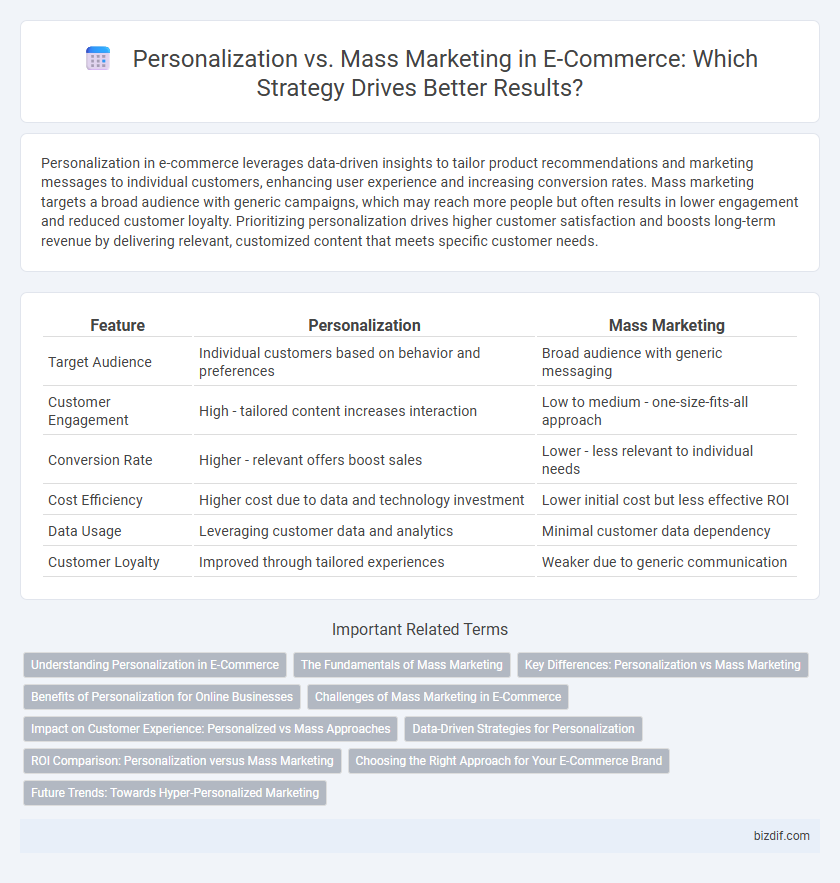Personalization in e-commerce leverages data-driven insights to tailor product recommendations and marketing messages to individual customers, enhancing user experience and increasing conversion rates. Mass marketing targets a broad audience with generic campaigns, which may reach more people but often results in lower engagement and reduced customer loyalty. Prioritizing personalization drives higher customer satisfaction and boosts long-term revenue by delivering relevant, customized content that meets specific customer needs.
Table of Comparison
| Feature | Personalization | Mass Marketing |
|---|---|---|
| Target Audience | Individual customers based on behavior and preferences | Broad audience with generic messaging |
| Customer Engagement | High - tailored content increases interaction | Low to medium - one-size-fits-all approach |
| Conversion Rate | Higher - relevant offers boost sales | Lower - less relevant to individual needs |
| Cost Efficiency | Higher cost due to data and technology investment | Lower initial cost but less effective ROI |
| Data Usage | Leveraging customer data and analytics | Minimal customer data dependency |
| Customer Loyalty | Improved through tailored experiences | Weaker due to generic communication |
Understanding Personalization in E-Commerce
Personalization in e-commerce involves tailoring product recommendations, promotions, and user experiences based on individual customer data such as browsing history, purchase behavior, and preferences. This targeted approach enhances customer engagement, increases conversion rates, and fosters brand loyalty by delivering relevant content and offers. Unlike mass marketing, which uses broad messaging to reach a wide audience, personalization leverages advanced algorithms and AI to create unique shopping experiences that meet specific consumer needs.
The Fundamentals of Mass Marketing
Mass marketing relies on broad campaigns targeting large audiences with a uniform message to maximize product reach and brand awareness. Its fundamentals include high-volume production, standardized messaging, and cost-effective media channels such as TV, radio, and print advertising. This approach often sacrifices individualized customer engagement to achieve economies of scale and simplified distribution.
Key Differences: Personalization vs Mass Marketing
Personalization in e-commerce targets individual customers using data-driven insights to deliver tailored product recommendations and customized shopping experiences, significantly enhancing customer engagement and conversion rates. Mass marketing, however, employs broad strategies aiming to reach large audiences with generic messaging, often resulting in lower relevance and engagement levels. Key differences include the use of customer data specificity, marketing message customization, and the overall impact on customer loyalty and sales effectiveness.
Benefits of Personalization for Online Businesses
Personalization in e-commerce enhances customer experience by tailoring product recommendations and promotions based on individual preferences and behaviors, increasing engagement and conversion rates. It drives higher customer loyalty and repeat purchases through relevant, timely interactions that mass marketing cannot replicate. Online businesses leveraging personalization see improved revenue growth and more efficient marketing spend by targeting specific segments with precision.
Challenges of Mass Marketing in E-Commerce
Mass marketing in e-commerce faces significant challenges such as reduced customer engagement due to generic messaging that fails to address individual preferences. The inability to leverage data-driven insights limits targeting accuracy, leading to lower conversion rates and higher customer acquisition costs. Additionally, increased competition and consumer demand for personalized experiences make mass marketing strategies less effective in fostering brand loyalty and repeat purchases.
Impact on Customer Experience: Personalized vs Mass Approaches
Personalization in e-commerce enhances customer experience by delivering tailored product recommendations and relevant content, increasing engagement and satisfaction. Mass marketing often leads to generic messaging that may overlook individual preferences, resulting in lower conversion rates and diminished brand loyalty. Data-driven personalization leverages customer behavior and purchase history to create unique interactions that foster trust and repeat business.
Data-Driven Strategies for Personalization
Data-driven strategies for personalization in e-commerce leverage customer behavior analytics, purchase history, and real-time interaction data to deliver tailored product recommendations and marketing messages. Advanced algorithms and machine learning models analyze vast datasets to predict customer preferences, enhancing user experience and increasing conversion rates. By shifting from mass marketing to personalized approaches, businesses achieve higher engagement, improved customer loyalty, and optimized return on investment.
ROI Comparison: Personalization versus Mass Marketing
Personalization in e-commerce drives a significantly higher ROI compared to mass marketing by targeting individual customer preferences and behavior, resulting in increased conversion rates and customer loyalty. Data shows personalized campaigns can generate up to 6x higher revenue per email than mass marketing efforts. Tailored recommendations and dynamic content reduce acquisition costs and maximize lifetime value, making personalization more cost-effective and impactful in driving sales growth.
Choosing the Right Approach for Your E-Commerce Brand
Personalization in e-commerce enhances customer engagement and conversion rates by tailoring product recommendations and marketing messages based on individual behaviors and preferences. Mass marketing reaches a broader audience with generalized campaigns, often resulting in lower acquisition costs but reduced relevance to consumers. Selecting the right approach depends on factors such as target market size, data availability, and marketing budget, with hybrid strategies increasingly popular to balance scale and personalization effectiveness.
Future Trends: Towards Hyper-Personalized Marketing
Future trends in e-commerce emphasize hyper-personalized marketing, leveraging AI and machine learning to analyze customer behavior and preferences at an individual level. Real-time data integration enables dynamic, tailored content and product recommendations that significantly enhance user engagement and conversion rates. Advanced segmentation techniques and predictive analytics drive marketing strategies that move beyond mass marketing to deliver unique, personalized experiences for each consumer.
Personalization vs Mass Marketing Infographic

 bizdif.com
bizdif.com